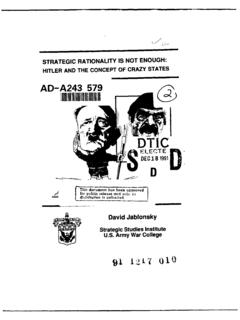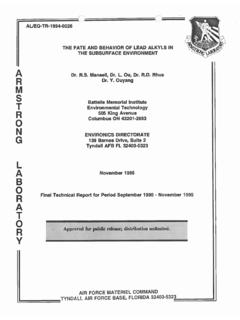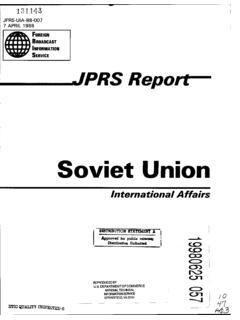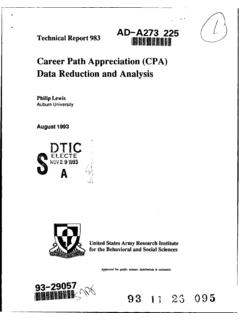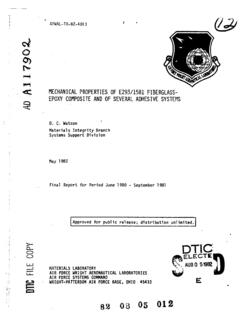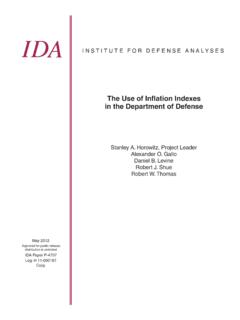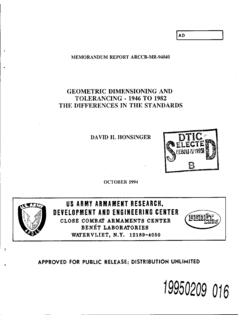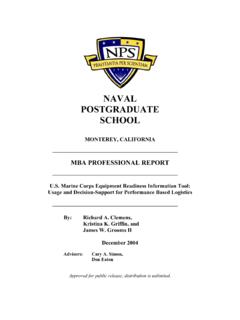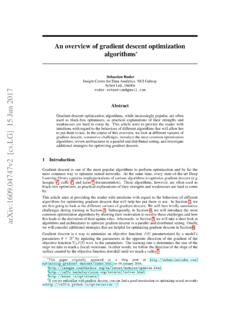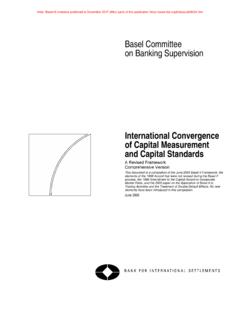Transcription of Reproduced if ike - DTIC
1 UNCLASSIFIED. Reproduced if ike ARMED SERVICES TECHNICAL INFORM ifflON AGENCY. ARLINGTON HAU STATION. ARLINGTON 12, VIRGINIA. UNCLASSIFIED. I. NOTICE: When government or other drawings, speci- fications or other data are used for any purpose other than In connection with a definitely related government procurement operation, the U. S. Government thereby Incurs no responsibility, nor any obligation whatsoever; and the fact that the Govern- ment may have formulated, furnished, or in any way supplied the said drawings, specifications, or other data is not to be regarded by Implication or other- wise as In any manner licensing the holder or any other person or corporation, or conveying any rights or permission to manufacture, use or sell any patented invention that may in any way be related thereto.
2 Technical Report ON CONVERGENCE PROOFS FOR PERCEPTRONS. Prepared for: OFFICE OF NAVAL RESEARCH. WASHINGTON, CONTRACT Nonr 3438(00). By: Alhert B. ]. Novikoff o utesEIT. January /96-3. Technical Report ON CONVERGENCE PROOFS FOR PERCEPTRONS. Prepared for: OFFICE OF NAVAL RESEARCH. WASHINGTON, CONTRACT Nonr 3438(00). By; Alhert B. /. Novikoff S RI Project No. 3605. Approved: C, A. ROSEN, MANAGER APPLIED PHYSICS LABORATORY. J. D. NOE, Dl^ldJR EilGINEERINS. E SCIENCES DIVISION. Copy No. ;', ABSTRACT. A short proof is given of the convergence (in a finite number of steps) of an algorithm for adjusting weights in a single-threshold device.
3 The algorithm in question can be interpreted as the error- correction procedure introduced by Rosenblatt for his "a-Perceptron. ". The proof presented extends the basic idea to continuous as well as discrete cases, and is interpreted geometrically. ii CONTENTS. ABSTHACT ". I INTRODUCTION *. 2. II STATEMENT OF THE THEOREM. 4. III PROOF OF THEOREM. IV AN ANALOGOUS TOEOREM 6. V GEOMETRICAL INTERPRETATION 8. ACKNOWLEDGMENT H. REFERENCES 12.. ill I INTRODUCTION. The purpose of this report is to exhibit an extremely short and, more notably, transparent proof of a theorem concerning perceptrons.
4 The theorem itself must now be considered one of the most basic theorems about perceptrons, and indeed, is among the first theorems proved by Rosenblatt and his collaborators. It also enjoys the peculiar distinc- tion of being one of the most often re-proved results in the field. The succession of proofs now available progresses from somewhat cloudy statements (which at one time caused doubt among "reasonable men" that the theorem was true) to comparatively crisp statements of a purely mathematical nature which nonetheless use more print than is strictly necessary. More to the point, latter-day proofs fail to enunciate a simple principle involved.
5 This principle permits one to modify the hypotheses in a variety of ways and secure similar results; it may well be useful in establishing genuinely new theorems of like character. We therefore present our proof in its entirety, in part to verify our claim that it is as short a line as can be drawn from hypotheses to conclusion, and also with the hope of terminating an already lengthy process of suc- cessive refinements. In addition, we prove a related theorem which is the continuous analogue of the perceptron theorem, and we indicate that various other theorems may be obtained by appropriately modifying the hypotheses.
6 We also discuss a geometrical interpretation of the per- ceptron theorem in terms of a convex cone and its dual. II STATEMENT OF THE THEOREM. Whereas previous proofs of the theorem appealed to a structure, called by Rosenblatt and his co-workers an a-perceptron, the present theorem, proof, and discussion apply without modification to a struc- ture consisting of a single threshold element acting on a weighted set of inputs. Theorem'. Let wl,..,wll be a set of vectors in a Euclidean space of fixed finite dimension, satisfying the hypothesis that there exists a vector y such that ( ) > > 0 1 N (1).
7 Consider the infinite sequence w. , ' ,w. 1 < i. < ^V for every k, 1 '2 3 ' . such that each vector , H occurs infinitely often. Recursively construct a sequence of vectors ,V,,..,v ,.. as follows: v0 is arbitrary n V. n ' < (2). The sequence {v ) is convergent , for some inde x m, v m v + l '. 2 v. Remarks (1) In particular, the theorem insures that ( ) > for i 1, ..N, since each wi occurs arbitrarily far out in the sequence {w. }. It ia only to obtain this consequence that we impose the restriction that each wi occurs infinitely often in the training sequence. (2) Theoretically, we may take 0 without loss of generality.}
8 However, this often has the effect of smuggling in numbers of large mag- nitude. For this reason, we retain the general 0, but in the concluding section we do consider the relation between the general case and the case 0 0. (3) In the private language of perceptron workers, the theorem reads as follows: A set of incoming signals is divided into two adjacent classes. A "satisfactory" assignment of weights from the associator units is defined as an assignment resulting in a response +1 for signals of Class I, and "1 for signals of Class II. The theorem asserts that no matter what assignment of weights we begin with, the process of re- cursively readjusting the weights by the method known as "error correc- tion" will terminate after a finite number of corrections in a satisfactory assignment, provided such a satisfactory assignment exists.
9 More briefly, a finite number of corrections will teach the perceptron to perform any given dichotomy of signals, if the dichotomy is within the capacity of the perceptron at all. The definition of -perceptron and the precise correspondence between the theorem's original verbal description and the purely mathematical assertion of the above theorem are provided by A brief glossary indicating the correspondence follows: the vector wi represents the activity of the associators, including class information, when stimulus 5. is presented. The vector y, which we assume to exist, represents a "satisfactory" assignment of associator weights; y has as many components as there are associators.
10 The sequence {wi } represents the "training ..,11. sequence," and the rule for defining {vn} describes the error-correction procedure. The positive number 0 is a threshold which must be exceeded for the response of the perceptron to be correct; a vector v such that ( pv) > 0 is an assignment of associator outputs which successfully classifies the ith signal. [If (v^v) < 0, then either the ith signal has been classified as belonging to the incorrect class or the perceptron has refrained from commitment, depending on whether or not the inequality is strict.]. (4) It is clear that because of Eq.
